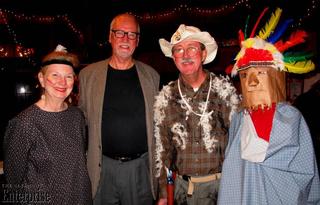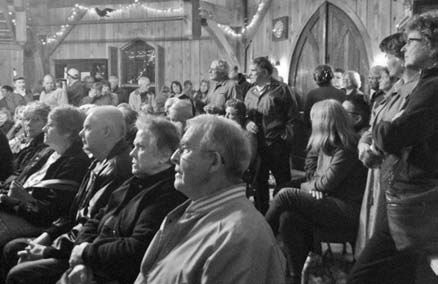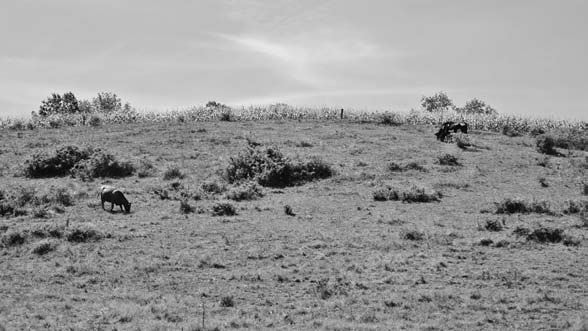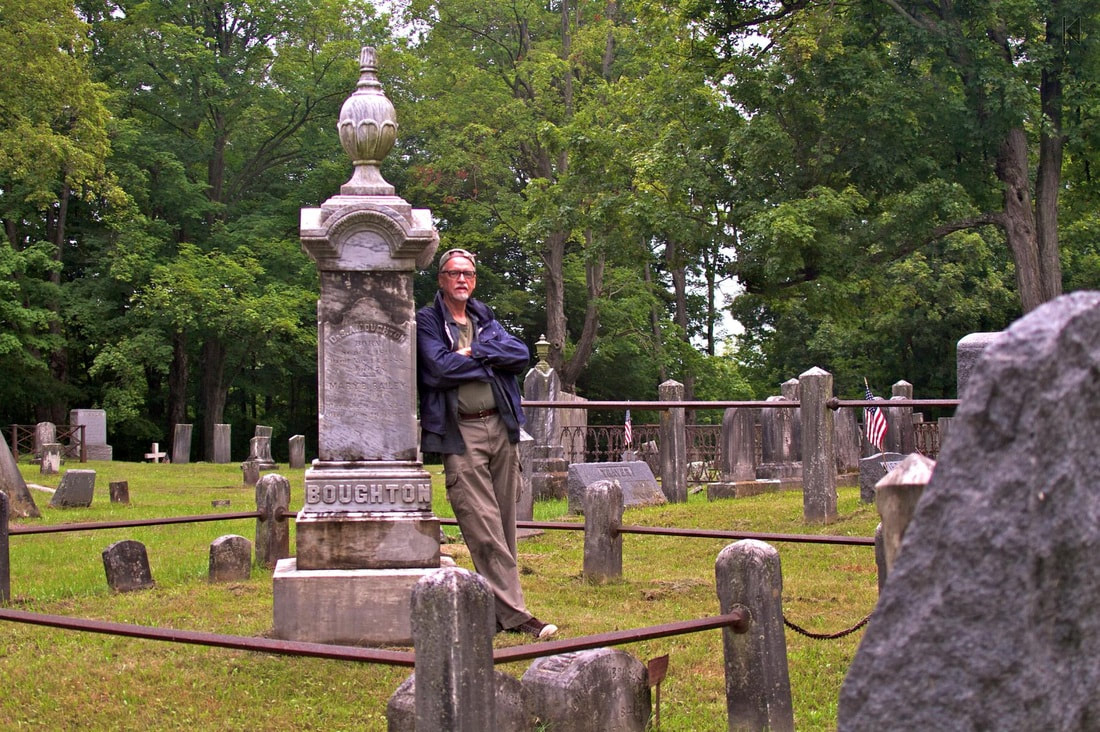Righteous Rebellion, October 2013
Enthusiastic reception for Righteous Rebellion
Altamont Enterprise, November 14, 2013
Altamont Enterprise, November 14, 2013
|
Dressed for the occasion: Hilltown residents who wore costumes to the screening of Righteous
Rebellion pose with filmmaker Bruce Kennedy. From left are Mary Kinnaird, dressed as an Indian; Kennedy; Russ Pokorny, dressed as a sheriff who has been tarred and feathered; and Amy Pokorny, dressed as a Calico Indian. (photo by Ron Barnell) |
To the Editor:
Filmmaker Bruce Kennedy is well qualified to bring the story of the 19th-Century uprising of the Helderberg-region tenant farmers against the patriarchal Van Rensselaer family and other wealthy Hudson Valley landowners, not just by the months of research that went into the production of his new documentary film, but also by the fact that he is a direct descendent of Dr. Smith Azer Boughton, principal leader of the Anti-Rent movement, who was imprisoned for his efforts to bring the tenant farmers out of the feudal-style servitude imposed upon them by 200 years of land and social authority.
All of these attendant historical facts and more were brought out by Bruce Kennedy at a talk given Oct. 30 to a capacity audience at the Octagon Barn in Knox, following the showing of a first version of his new documentary film, Righteous Rebellion — America’s Anti-Rent War.
The film begins by exploring the cultural attitudes of the time — how the fervor of the American and other worldwide revolutions set the stage for what was to become an uprising of the last vestiges of a system of indenture set upon those who worked the land that was being heavily taxed by a small minority of the privilegedclass landlords.
During the course of the film, many facets of the tenant farmers’ rebellion were illustrated, such as the blowing of tin horns to warn the Hilltown populace of the approach of the sheriff and militia coming to serve arrest warrants or force tenants off the land for non-payment of taxes. Resistance measures included tar and feathering of militia members, and farmers dressed as “calico Indians” who rode through the countryside and harassed agents of the landlords.
The film’s conclusion related how the yoke of indentured leasehold tenure by the privileged landlords was finally lifted in the 1850s through this popular Helderberg uprising, combined with political and legal maneuverings. Kennedy’s film nicely comes full circle, to show how the anti-rent revolt would sow fertile seeds for later aspects of the abolitionist and suffragette movements, much of which would take place in upstate New York.
In a lively question-and-answer session following the showing of the film, Mr. Kennedy explained many of the steps that went into the production of the film, from months of exhaustive research, editing, and several intensive revisions.
Kennedy wanted the story of the Anti-Rent War to incorporate a personal touch; this he accomplished by coming to the region (Kennedy presently lives in North Carolina) to film interviews with members of local families who were direct descendents of many of the residents who had a direct role and active participation in the Helderberg uprising.
Several local history enthusiasts and officials also appear on-camera to lend some historical perspective as the story unfolds. Many of the people that appear in the film were also present at the screening and were able to amplify on their contributions.
Bruce Kennedy will now be going back to work on Righteous Rebellion with some finishing touches and adjustments to bring his engaging story of the Helderberg Anti-Rent War film to completion. When asked about the distribution of the final production, he intimated that he may approach PBS for a showing as one possibility.
I had mentioned during the course of the talk that the story of the anti-rent rebellion was even taken up by Hollywood in 1946, with the release of the film Dragonwyck, based upon a novel by Anya Seton, with Vincent Price and Gene Tierney as the leading stars. Price plays a thinly veiled role of Stephen Van Rensselaer, in a Gothic romance style that incorporates a somewhat fictionalized account of the anti-rent rebellion.
Bruce Kennedy’s film, Righteous Rebellion, offers a first-time realistic overview of the historical precedents that led to the Anti- Rent War in the local area and its lingering aftermath. Judging by the overwhelming enthusiastic reception it received in late October in Knox, Kennedy’s film could play to further critical acclaim if it gets the opportunity for a much wider showing.
Bruce Kennedy’s appearance and film screening were co-sponsored by the Berne and Knox Historical Societys, the Helderberg Hilltowns Association, and the Helderberg Kiwanis Club.
Ron Barnell
Schenectady
Filmmaker Bruce Kennedy is well qualified to bring the story of the 19th-Century uprising of the Helderberg-region tenant farmers against the patriarchal Van Rensselaer family and other wealthy Hudson Valley landowners, not just by the months of research that went into the production of his new documentary film, but also by the fact that he is a direct descendent of Dr. Smith Azer Boughton, principal leader of the Anti-Rent movement, who was imprisoned for his efforts to bring the tenant farmers out of the feudal-style servitude imposed upon them by 200 years of land and social authority.
All of these attendant historical facts and more were brought out by Bruce Kennedy at a talk given Oct. 30 to a capacity audience at the Octagon Barn in Knox, following the showing of a first version of his new documentary film, Righteous Rebellion — America’s Anti-Rent War.
The film begins by exploring the cultural attitudes of the time — how the fervor of the American and other worldwide revolutions set the stage for what was to become an uprising of the last vestiges of a system of indenture set upon those who worked the land that was being heavily taxed by a small minority of the privilegedclass landlords.
During the course of the film, many facets of the tenant farmers’ rebellion were illustrated, such as the blowing of tin horns to warn the Hilltown populace of the approach of the sheriff and militia coming to serve arrest warrants or force tenants off the land for non-payment of taxes. Resistance measures included tar and feathering of militia members, and farmers dressed as “calico Indians” who rode through the countryside and harassed agents of the landlords.
The film’s conclusion related how the yoke of indentured leasehold tenure by the privileged landlords was finally lifted in the 1850s through this popular Helderberg uprising, combined with political and legal maneuverings. Kennedy’s film nicely comes full circle, to show how the anti-rent revolt would sow fertile seeds for later aspects of the abolitionist and suffragette movements, much of which would take place in upstate New York.
In a lively question-and-answer session following the showing of the film, Mr. Kennedy explained many of the steps that went into the production of the film, from months of exhaustive research, editing, and several intensive revisions.
Kennedy wanted the story of the Anti-Rent War to incorporate a personal touch; this he accomplished by coming to the region (Kennedy presently lives in North Carolina) to film interviews with members of local families who were direct descendents of many of the residents who had a direct role and active participation in the Helderberg uprising.
Several local history enthusiasts and officials also appear on-camera to lend some historical perspective as the story unfolds. Many of the people that appear in the film were also present at the screening and were able to amplify on their contributions.
Bruce Kennedy will now be going back to work on Righteous Rebellion with some finishing touches and adjustments to bring his engaging story of the Helderberg Anti-Rent War film to completion. When asked about the distribution of the final production, he intimated that he may approach PBS for a showing as one possibility.
I had mentioned during the course of the talk that the story of the anti-rent rebellion was even taken up by Hollywood in 1946, with the release of the film Dragonwyck, based upon a novel by Anya Seton, with Vincent Price and Gene Tierney as the leading stars. Price plays a thinly veiled role of Stephen Van Rensselaer, in a Gothic romance style that incorporates a somewhat fictionalized account of the anti-rent rebellion.
Bruce Kennedy’s film, Righteous Rebellion, offers a first-time realistic overview of the historical precedents that led to the Anti- Rent War in the local area and its lingering aftermath. Judging by the overwhelming enthusiastic reception it received in late October in Knox, Kennedy’s film could play to further critical acclaim if it gets the opportunity for a much wider showing.
Bruce Kennedy’s appearance and film screening were co-sponsored by the Berne and Knox Historical Societys, the Helderberg Hilltowns Association, and the Helderberg Kiwanis Club.
Ron Barnell
Schenectady
Crowd turns out for documentary on Anti-Rent WarAltamont Enterprise, November 7, 2013
To the Editor:
One-hundred-and-forty people or more crowded the Octagon Barn in Knox on Oct. 30 to view a rough edit of Righteous Rebellion: America’s Anti-Rent War on Privilege. They met filmmaker Bruce Kennedy and offered him feedback about the documentary.
This slice of local history still resonates strongly today, as proven by the large audience of students, history enthusiasts, town officials, and Anti-Rent War descendants.
The Kiwanis Club of the Helderbergs would like to thank cosponsors Berne Historical Society, Helderberg Hilltowns Association, and Knox Historical Society for organizing this event. Thanks also go out to the viewers and especially to Bruce Kennedy, who traveled here from North Carolina because, as he says, “The Helderbergs is where it all began.”
Amy Lauterbach Pokorny,
President, Kiwanis Club of the Helderbergs
One-hundred-and-forty people or more crowded the Octagon Barn in Knox on Oct. 30 to view a rough edit of Righteous Rebellion: America’s Anti-Rent War on Privilege. They met filmmaker Bruce Kennedy and offered him feedback about the documentary.
This slice of local history still resonates strongly today, as proven by the large audience of students, history enthusiasts, town officials, and Anti-Rent War descendants.
The Kiwanis Club of the Helderbergs would like to thank cosponsors Berne Historical Society, Helderberg Hilltowns Association, and Knox Historical Society for organizing this event. Thanks also go out to the viewers and especially to Bruce Kennedy, who traveled here from North Carolina because, as he says, “The Helderbergs is where it all began.”
Amy Lauterbach Pokorny,
President, Kiwanis Club of the Helderbergs
Spurred by his ancestor’s words
Kennedy makes a pilgrimage to the Helderbergs to film a story of rebellion
By Marcello IaiaAltamont Enterprise, November 14, 2013
BERNE — Cars covered in a veneer of frost and snow from the Hilltowns can be seen this time of year driving among dry and gleaming ones on the roads below. Bruce Kennedy thinks the distinct environment up here, with stony land unsuited for agriculture, was a major reason the Anti-Rent rebellion of the 19th Century started in the Helderbergs.
Kennedy, a filmmaker and descendant of one of the rebellion’s leaders, arrived in Altamont last summer after a year of intense research and a lifetime of awe at the story of justice.
“I’m looking up at this and I realize, that’s the Helderberg, that’s it, that’s the escarpment,” said Kennedy, who lives in North Carolina. “I was thrilled. I was actually very excited. It’s a pile of rocks, but it’s amazing because I knew what it meant. It was a key player in this whole process.”
Large swaths of land owned by the Van Rensselaer family were first given over to farmers in the early 1600s. The tenants had no timber, water, or mineral rights. After having developed the land for years, or even generations, the tenant farmers had perpetual leases requiring them to pay rent in bushels of wheat, four fowl, and a day of labor with horses and wagon.
If tenants wanted to release what they had to another tenant, the patroon, or owner would get a quarter of the sale. The Dutch patroon system is often described as semi-feudal.
“So here, the lords here had this tremendous amount of power and they could compete with the government,” Kennedy explained. The government couldn’t undo them.”
Once a book designer, an adagency manager, and a commercial photographer, Kennedy, at 64, is now making films, sculptures, and paintings. He was celebrated by around 150 spectators in the Knox Octogan Barn on Oct. 30, when he showed a rough cut of his documentary on the tumultuous period of the Anti-Rent War that eventually spread through several counties in the state.
Kennedy hopes to present his Anti-Rent rebellion project to a television network for a series. Sitting by the window of the FoxCreek Market with his wife, Carmen Ramos-Kennedy, a political activist, Kennedy described his first efforts to seek out material for his documentary, Righteous Rebellion: America’s Anti-Rent
War on Privilege.
Kennedy walked into the same market in Berne and asked the first person he saw what he knew of the Anti-Rent War. He was given a list of names.
“I asked the kid I bought my pizza from,” Kennedy went on. “He said, ‘Oh, yeah, my history teacher, Andy Wright.’” Wright is among several local descendants who appear in Kennedy’s film, which, he says, has a central message about humans that casts light on “corporate feudalism” of today and activities like the Occupy movement started in 2011.
“My intent is to link the fact that rebellion is in people’s blood,” Kennedy explained. “That message is, I believe, largely suppressed. We’re not supposed to know that. You’re not taught that in school, that people can rebel and get what they want, and yet it happens all the time and has happened all the time.”
Ancestral quest
Kennedy was born in Troy and grew up in Connecticut, Rhode Island, and Delaware where he graduated from high school. “My dad was a difficult, brilliant man,” Spurred by his ancestor’s words Kennedy makes a pilgrimage to the Helderbergs to film a story of rebellion Kennedy said of his father, an engineer and researcher with a Ph.D. from Yale.
As a boy, Kennedy said he was told stories of his great-greatgreat- grandfather, Smith Azer Boughton, a country doctor who led rallies and was known in Calico Indian disguise as “Big Thunder.” The Anti- Renters, like the more famous provokers of the Boston Tea Party, wore Indian costumes as they rebelled.
“I think he was instrumental in developing the idea of paralleling the Boston Tea Party,” Kennedy said. “He certainly was part of that planning of, ‘OK, let’s disguise ourselves.’ Because what they were doing was illegal and they were resisting the sheriffs.”
During his six-week trip packed with interviews and visiting historical societies, Kennedy went to Alps in Rensselaer County, where Dr. Boughton lived. When he visited his grandmother as a child, Kennedy said, he and other children in the family would be obligated to walk around the corner to their ancestor’s old house, stand, and listen to the story of Dr. Bouton.
“As a kid, it intrigued me not so much, except for the disguises and riding-around-on-horses stuff,” said Kennedy. “But later, as I got older, I realized that this was really about justice. And here was a man who didn’t really have a dog in this fight.”
Kennedy said he has a letter from Dr. Boughton to his grandson, titled “My interesting life,” from which he learned some of his story. His ancestor also appears in the iconic volume telling the history of the Anti- Rent War, Tin Horns and Calico by Henry Christman, which Kennedy said is a authoritative source in his research.
Roots of rebellion
Studying fine art at the Pratt Institute in the late 1960s, Kennedy became frustrated with the system of schools and designated curricula. After learning that a friend was studying silk-screening because he was in a separate school within the institute, Kennedy said he posted signs, asking fellow students whether they felt the same way, and would they meet — 150 people gathered. Kennedy was encouraged by the institute’s administration to take up the issue with the head of the School of Fine Art.
“He said, ‘I understand your frustrations and I sympathize, but, you know what, I’m not giving up any of my power,’” Kennedy recounted. “And that cynicism to my idealism was so crushing, so awful, that that was one of the major things that said, ‘I’m out of here. I can’t put up with this.’”
Kennedy didn’t graduate, leaving the institute in 1969 to establish a book-design studio. That same year, he said, a group of students went on strike, sitting in the deans’ offices, their issues focused on the structure of their institution. “By the second year, I had $10,000 in debt, which seemed an incredible amount of money,” Kennedy said of his finances as a student. Kennedy later went on to earn more money in magazine publishing, as a marketing consultant, and with ad agencies in California.
“Advertising isn’t about telling the truth,” Kennedy said of his discouragement with the industry. “It’s about telling enough to interest people in buying something, something they probably don’t want or need, but you want to convince them to.”
After a long road trip with Ramos- Kennedy, the couple settled in Asheville, N.C., where they live now. Ramos-Kennedy has since been involved in political campaigns, including the 2012 presidential bid by Barack Obama. She said she is now on the advisory board for the Campaign for Southern Equality, focused on lesbian, gay, bi-sexual, and transgender issues in the South.
Kennedy has developed his fine art and teaches middle-school students in movie-making. “I’m trying to help them tell their stories, he said.
Kennedy makes a pilgrimage to the Helderbergs to film a story of rebellion
By Marcello IaiaAltamont Enterprise, November 14, 2013
BERNE — Cars covered in a veneer of frost and snow from the Hilltowns can be seen this time of year driving among dry and gleaming ones on the roads below. Bruce Kennedy thinks the distinct environment up here, with stony land unsuited for agriculture, was a major reason the Anti-Rent rebellion of the 19th Century started in the Helderbergs.
Kennedy, a filmmaker and descendant of one of the rebellion’s leaders, arrived in Altamont last summer after a year of intense research and a lifetime of awe at the story of justice.
“I’m looking up at this and I realize, that’s the Helderberg, that’s it, that’s the escarpment,” said Kennedy, who lives in North Carolina. “I was thrilled. I was actually very excited. It’s a pile of rocks, but it’s amazing because I knew what it meant. It was a key player in this whole process.”
Large swaths of land owned by the Van Rensselaer family were first given over to farmers in the early 1600s. The tenants had no timber, water, or mineral rights. After having developed the land for years, or even generations, the tenant farmers had perpetual leases requiring them to pay rent in bushels of wheat, four fowl, and a day of labor with horses and wagon.
If tenants wanted to release what they had to another tenant, the patroon, or owner would get a quarter of the sale. The Dutch patroon system is often described as semi-feudal.
“So here, the lords here had this tremendous amount of power and they could compete with the government,” Kennedy explained. The government couldn’t undo them.”
Once a book designer, an adagency manager, and a commercial photographer, Kennedy, at 64, is now making films, sculptures, and paintings. He was celebrated by around 150 spectators in the Knox Octogan Barn on Oct. 30, when he showed a rough cut of his documentary on the tumultuous period of the Anti-Rent War that eventually spread through several counties in the state.
Kennedy hopes to present his Anti-Rent rebellion project to a television network for a series. Sitting by the window of the FoxCreek Market with his wife, Carmen Ramos-Kennedy, a political activist, Kennedy described his first efforts to seek out material for his documentary, Righteous Rebellion: America’s Anti-Rent
War on Privilege.
Kennedy walked into the same market in Berne and asked the first person he saw what he knew of the Anti-Rent War. He was given a list of names.
“I asked the kid I bought my pizza from,” Kennedy went on. “He said, ‘Oh, yeah, my history teacher, Andy Wright.’” Wright is among several local descendants who appear in Kennedy’s film, which, he says, has a central message about humans that casts light on “corporate feudalism” of today and activities like the Occupy movement started in 2011.
“My intent is to link the fact that rebellion is in people’s blood,” Kennedy explained. “That message is, I believe, largely suppressed. We’re not supposed to know that. You’re not taught that in school, that people can rebel and get what they want, and yet it happens all the time and has happened all the time.”
Ancestral quest
Kennedy was born in Troy and grew up in Connecticut, Rhode Island, and Delaware where he graduated from high school. “My dad was a difficult, brilliant man,” Spurred by his ancestor’s words Kennedy makes a pilgrimage to the Helderbergs to film a story of rebellion Kennedy said of his father, an engineer and researcher with a Ph.D. from Yale.
As a boy, Kennedy said he was told stories of his great-greatgreat- grandfather, Smith Azer Boughton, a country doctor who led rallies and was known in Calico Indian disguise as “Big Thunder.” The Anti- Renters, like the more famous provokers of the Boston Tea Party, wore Indian costumes as they rebelled.
“I think he was instrumental in developing the idea of paralleling the Boston Tea Party,” Kennedy said. “He certainly was part of that planning of, ‘OK, let’s disguise ourselves.’ Because what they were doing was illegal and they were resisting the sheriffs.”
During his six-week trip packed with interviews and visiting historical societies, Kennedy went to Alps in Rensselaer County, where Dr. Boughton lived. When he visited his grandmother as a child, Kennedy said, he and other children in the family would be obligated to walk around the corner to their ancestor’s old house, stand, and listen to the story of Dr. Bouton.
“As a kid, it intrigued me not so much, except for the disguises and riding-around-on-horses stuff,” said Kennedy. “But later, as I got older, I realized that this was really about justice. And here was a man who didn’t really have a dog in this fight.”
Kennedy said he has a letter from Dr. Boughton to his grandson, titled “My interesting life,” from which he learned some of his story. His ancestor also appears in the iconic volume telling the history of the Anti- Rent War, Tin Horns and Calico by Henry Christman, which Kennedy said is a authoritative source in his research.
Roots of rebellion
Studying fine art at the Pratt Institute in the late 1960s, Kennedy became frustrated with the system of schools and designated curricula. After learning that a friend was studying silk-screening because he was in a separate school within the institute, Kennedy said he posted signs, asking fellow students whether they felt the same way, and would they meet — 150 people gathered. Kennedy was encouraged by the institute’s administration to take up the issue with the head of the School of Fine Art.
“He said, ‘I understand your frustrations and I sympathize, but, you know what, I’m not giving up any of my power,’” Kennedy recounted. “And that cynicism to my idealism was so crushing, so awful, that that was one of the major things that said, ‘I’m out of here. I can’t put up with this.’”
Kennedy didn’t graduate, leaving the institute in 1969 to establish a book-design studio. That same year, he said, a group of students went on strike, sitting in the deans’ offices, their issues focused on the structure of their institution. “By the second year, I had $10,000 in debt, which seemed an incredible amount of money,” Kennedy said of his finances as a student. Kennedy later went on to earn more money in magazine publishing, as a marketing consultant, and with ad agencies in California.
“Advertising isn’t about telling the truth,” Kennedy said of his discouragement with the industry. “It’s about telling enough to interest people in buying something, something they probably don’t want or need, but you want to convince them to.”
After a long road trip with Ramos- Kennedy, the couple settled in Asheville, N.C., where they live now. Ramos-Kennedy has since been involved in political campaigns, including the 2012 presidential bid by Barack Obama. She said she is now on the advisory board for the Campaign for Southern Equality, focused on lesbian, gay, bi-sexual, and transgender issues in the South.
Kennedy has developed his fine art and teaches middle-school students in movie-making. “I’m trying to help them tell their stories, he said.
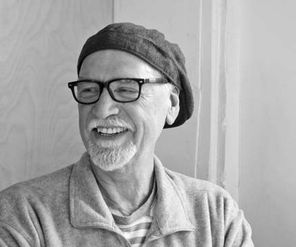
Bruce Kennedy, a filmmaker now editing a documentary about rebellion and the Anti-Rent War, smiles after being groomed by his wife, Carmen Ramos-Kennedy, for a picture
|
Hardscrabble hill: Cows graze on a steep rise facing Irish Hill Road in Berne, where the initial unrest for the 19th Century Anti-Rent War rumbled. Documentary filmmaker Bruce Kennedy believes the difficulty of certain types of agriculture with the thin topsoil in parts of the Hilltowns played a role in Berne being a focal point for the farmers’ revolt. |
Righteous Rebellion screened at the Octagon Barn
Altamont Enterprise, October 24, 2013
Altamont Enterprise, October 24, 2013
To the Editor:
Filmmaker Bruce Kennedy will show a rough edit of his documentary Righteous Rebellion: America’s Anti-Rent War on Privilege on Wednesday, Oct. 30, at the Octagon Barn in Knox. Sponsored by the Kiwanis Club of the Helderbergs, this will be the only screening in Albany County.
Kennedy, originally from Troy, is a great-great-great-grandson of Dr. Smith Azer Boughton, known as “Big Thunder.” Boughton, a brilliant public speaker and principal leader of the Anti-Rent movement, was imprisoned for his efforts to lead the tenant farmers out of indentured servitude.
He proclaimed, “The purpose of our society is not for the few of maximum strength and ambition to lead lives of Byzantine glory, but for men to make the most of their common humanity.”
Kennedy, now based in North Carolina, visited the area in August, conducting research for his documentary and interviewing individuals with connections to the Anti-Rent movement. The event will begin with a meet-and-greet session at 6 p.m., followed by the film at 7. Afterward, the audience members will have an opportunity to discuss the topic with Kennedy and each other.
The public, including families with school-age children, is invited to this free event. The screening is co-sponsored by Berne Historical Society, Helderberg Hilltowns Association, and Knox Historical Society. Refreshments will be served. The Octagon Barn is located at 588 Middle Road in Knox (Route 262, Delanson 12053 for GPS).
For more information, contact me at 872-2082 or [email protected].
John Elberfeld
Board, Kiwanis Club of the Helderbergs
Filmmaker Bruce Kennedy will show a rough edit of his documentary Righteous Rebellion: America’s Anti-Rent War on Privilege on Wednesday, Oct. 30, at the Octagon Barn in Knox. Sponsored by the Kiwanis Club of the Helderbergs, this will be the only screening in Albany County.
Kennedy, originally from Troy, is a great-great-great-grandson of Dr. Smith Azer Boughton, known as “Big Thunder.” Boughton, a brilliant public speaker and principal leader of the Anti-Rent movement, was imprisoned for his efforts to lead the tenant farmers out of indentured servitude.
He proclaimed, “The purpose of our society is not for the few of maximum strength and ambition to lead lives of Byzantine glory, but for men to make the most of their common humanity.”
Kennedy, now based in North Carolina, visited the area in August, conducting research for his documentary and interviewing individuals with connections to the Anti-Rent movement. The event will begin with a meet-and-greet session at 6 p.m., followed by the film at 7. Afterward, the audience members will have an opportunity to discuss the topic with Kennedy and each other.
The public, including families with school-age children, is invited to this free event. The screening is co-sponsored by Berne Historical Society, Helderberg Hilltowns Association, and Knox Historical Society. Refreshments will be served. The Octagon Barn is located at 588 Middle Road in Knox (Route 262, Delanson 12053 for GPS).
For more information, contact me at 872-2082 or [email protected].
John Elberfeld
Board, Kiwanis Club of the Helderbergs
|
|
Documentarian Bruce Kennedy stands by the grave of his great-great-great-grandfather, Dr. Smith
Azer Boughton, or “Big Thunder,” one of the principal leaders of the Anti-Rent rebellion. Kennedy will show a rough edit of his film “Righteous Rebellion” at the Octagon Barn in Knox on Wednesday, Oct. 30. The public is invited to meet the filmmaker at 6, followed by the screening at 7 p.m. |
